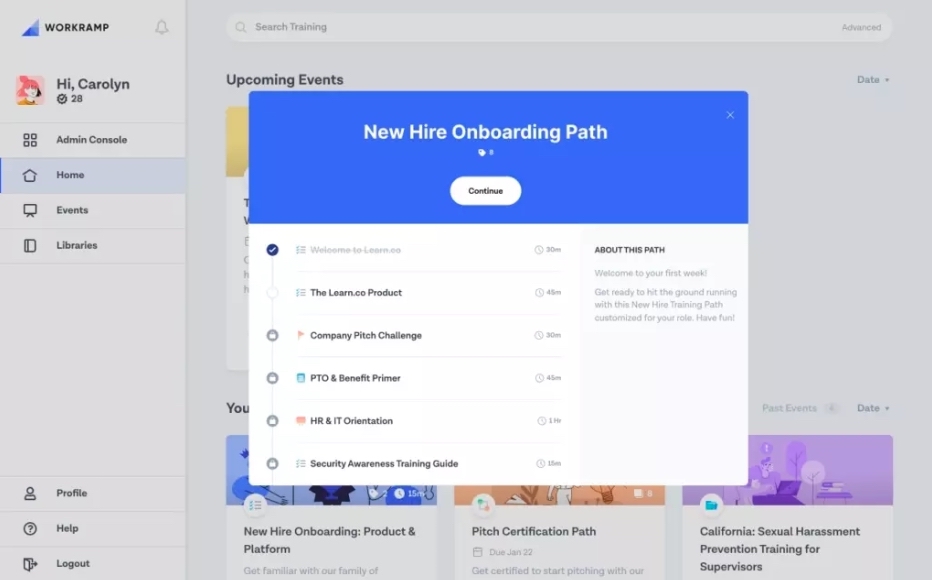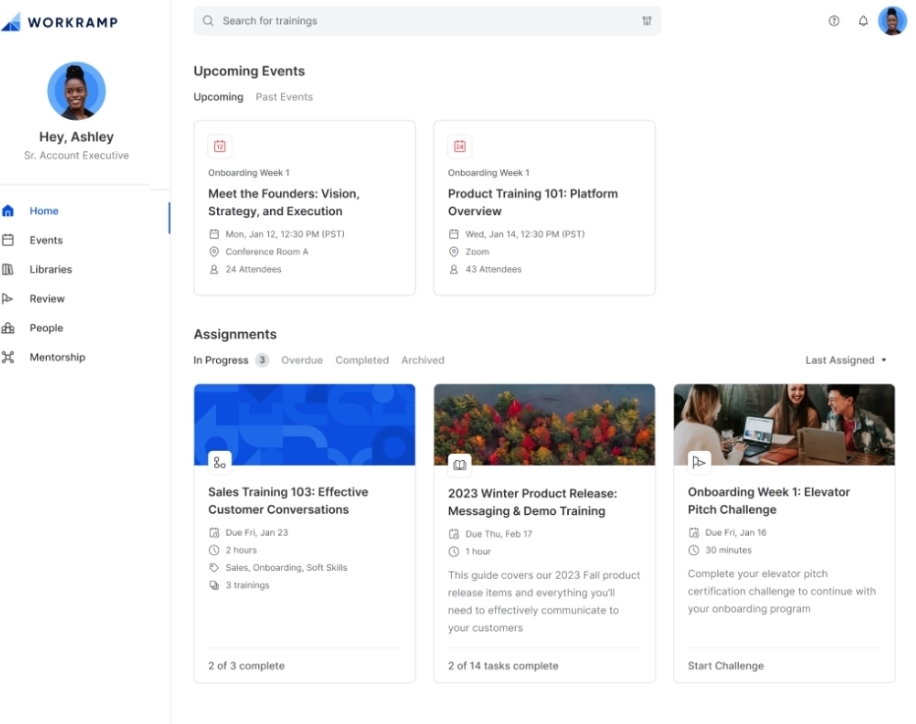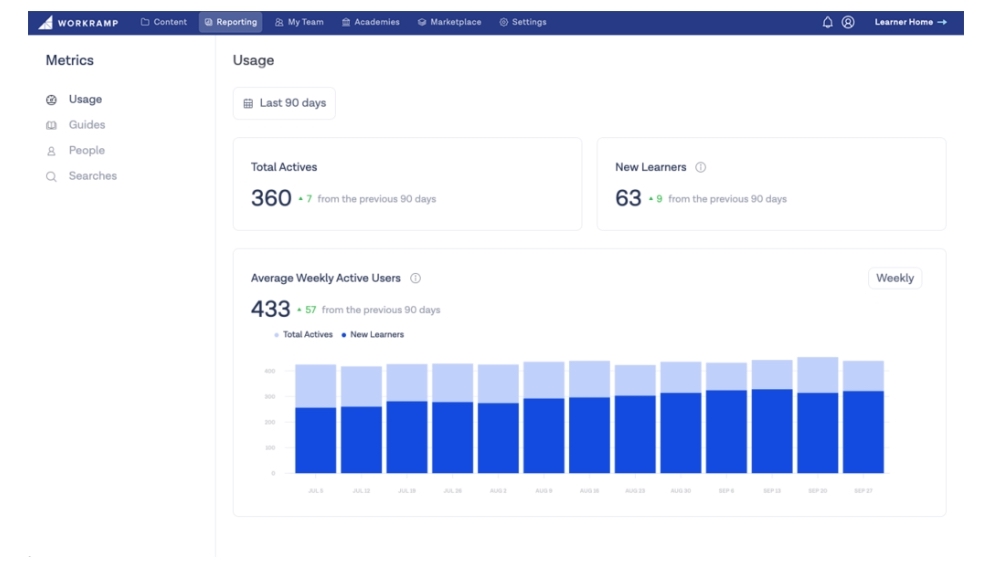What is Professional Development and Why is it Crucial for Success?
Michael Keenan | WorkRamp Contributor
View bioLearning Tips Straight to Your Inbox
Professional development is the ongoing process of gaining new skills and training to advance professionally. We don’t need to overthink professional development. There are opportunities everywhere to learn and improve skills. This includes attending conferences, taking courses, participating in mentorship programs, and more.
Think of professional development as planting a garden. You must regularly tend the soil, pull the weeds, and prune the plants to keep them healthy and productive.
Yet, 80 percent of professionals don’t think their current employer provides growth opportunities. It’s clear organizations must care for employees’ professional development to remain competitive in rapidly changing markets.
The skills needed to perform a job often change, and with the ongoing War for Talent, professional development is a significant way to attract and retain skilled, high-potential employees.
In this post:
Why is professional development important for companies?
A competitive job market and rapid technological advances led to the need for professional development in the 1960s. Around then, professional development programs began to emerge, allowing employees to learn new skills.
Here are four main reasons to invest in professional development.
Employees want to grow
Learning and development (L&D) is the top benefit employees want from employers.
One study found that 32 percent of tech workers said self-improvement, through development or tuition reimbursement, was the most valued aspect of their job. Professional development is more important to employees than health and wealth programs and in-office perks.
Hiring new employees is expensive
A lot of time and effort goes into hiring new employees. The average cost of hiring an employee is around $4,000, According to a Glassdoor study. Various factors affect that number, such as:
- Business size
- Location
- Role you’re hiring for
- Industry
Giving team members a chance to learn can increase employee engagement. That’s correlated with higher retention and lower hiring costs.
Professional development leads to more innovation
Professional development unlocks the potential in your workforce. Organizations with a strong learning culture are more likely to develop unique processes and products.
Development programs bring new skills to employees, which they can use in current or future roles. Eighty-four percent of employees in the best-performing organizations receive the training they need, compared to 16 percent in the worst-performing companies.
Keeps organizations competitive
In-demand skills are a moving target. They change continuously, and it isn’t easy to remain competitive without proper training.
The World Economic Forum predicts that 1.1 billion jobs will radically transform over the next decade. Preparing the workforce with the necessary skills will future-proof their careers and keep your company ahead of the competition.
What are the benefits of professional development?
Elevate employee knowledge and advancement
A recent work retention study found that 20 percent of employees voluntarily leave their jobs because of a lack of career development and training. Millennial workers, who’ll make up 75 percent of the workforce by 2030, are more likely to leave a company that doesn’t invest in their professional development.
Arming employees with new knowledge and advancement opportunities creates a thriving work environment. It can also attract new talent and empower existing employees to enhance their strengths.
Increase job satisfaction
Professional development can do wonders for boosting job satisfaction. It can increase employees’ confidence in their work, which translates to higher job satisfaction and morale.
Investing in employees’ professional development shows you care about their future ambitions. When employees know you’ll provide top-notch training, it makes them feel valued, which improves morale.
Lower turnover
The average employee turnover rate is around 11 percent, according to a study by Praisdio. The big win with professional development is that you can create career development opportunities for everyone in your organization.
Investing in your employees’ skills and development will improve their performance as they reach their career goals. As a result, more employees will stick around longer.
78 percent of employees say a clear career path would compel them to stay with an organization longer.
Fill skills gaps
Surveys show that 58 percent of companies say closing skill gaps in their workforce has become a higher priority since the pandemic began. Professional development opportunities provide new skills and knowledge for employees and combat any weaknesses they face.
Promotes collaboration
No matter the size of your company, it takes a lot of work to promote collaboration across departments. A professional development program brings teams together to discuss topics and establish bonds.
Let’s say you host a workshop on effective communication. You could invite people from different departments, and they share their roles, responsibilities, challenges, and what they need to thrive during the workshop.
They also learn skills to communicate effectively. This helps different teams understand each other and share ideas, which results in more successful cross-department collaborations.
How to encourage professional development
Understand employees’ needs
You can create a more effective development program when you discover employees’ underlying ambitions.
The first step happens during onboarding through self-assessment. This helps employees better understand their current skill set, knowledge gaps, strengths, and areas for improvement.
Studies also show that onboarding experiences that provide employees with a clear path are 3.5x more likely to be rated as exceptional. Using software like WorkRamp, you can build tailored onboarding programs to encourage productive, happy employees.

Some ways to understand an employee’s needs post-onboarding are:
- One-on-one meetings
- Employee observations
- Annual surveys
Discuss long-term goals and identify areas where employees need additional support. Use the information you collect to create customized L&D plans.
Read more: How to Create Career Paths for Your Employees
Partner with industry experts
Another way to encourage professional development is by partnering with industry experts. Have subject matter experts teach a workshop or course on a particular topic.
This gives learners access to the most up-to-date, relevant industry knowledge. Plus, they benefit from the experience and expertise of an industry professional.
For example, a learner brushing up on AI and software engineering can understand how to improve their processes. It can also help them prepare to transition into a better role within your organization, which is more cost-effective than hiring externally.
Use an LMS
The right tools can help you streamline the professional development process. Invest in a Learning Management System (LMS).

WorkRamp, for example, is an All-in-One Learning Platform that makes it easy to build custom development programs. With a learning platform like WorkRamp, you can:
- Customize the platform
- Set up new courses
- Import external courses
- Create learning paths
- Track learner progress
- Assess skills and knowledge
- Provide custom certifications
An LMS is the central location for all your learning content for employees and administrators. With a learning platform, you can deliver top-level training for your employees and upskill with ease.
Read More: How to Find the Right Tool for Online Employee Training
Create a mentorship program
Mentorship programs help employees gain skills through another experienced worker. These programs have become popular in recent years, with roughly a third of organizations increasing their mentoring efforts since the start of the pandemic, according to HR.com’s 2021 State of Coaching and Mentoring Report.
Compared to coaching, mentoring is less formal. There are no direct instructions or reporting. For example, a company leader may regularly meet with an employee to share advice about different topics, like negotiating a raise or resolving conflicts.
Read More: How to Create a Coaching Culture to Support Employee Development
Motivate employees to participate
For many people, training can feel like a snooze-fest. This makes it hard for people to engage in learning and achieve their training goals.
Fortunately, there are a few easy ways to encourage active participation:
- Make training practical and relevant. Analyze employee objectives and create materials to help them improve.
- Create a learning culture. Show employees that you value continuous learning. Support risk-taking and failing forward so learners are comfortable with making mistakes.
- Gamify learning. Add game-like, interactive content to learning materials. Elements such as point scoring and peer competitions encourage people to participate in education programs.
Overall, aim to make learning a fun experience. Ensure employees can take courses anywhere, on any device so that they can develop their skills on their own time.
What makes a strong professional development program?
Continuous microlearning opportunities
Microlearning enhances knowledge retention and performance through short, bite-sized content. Learners can access these materials on demand when they need them.
Microlearning assets are filled with key points and information. Common types include:
- How-to videos
- Self-paced e-learning
- Job aids
- Podcasts
- Ebooks
- Blog posts
- Battle cards
Read More: eLearning Content: 24 Types to Include in Training
With microlearning material options at your employees’ disposal, they can repeatedly visit and study assets, which improves learner retention.
Formal and informal learning opportunities
There is no one-size-fits-all for development programs. What works for someone on your development team may not work for someone in marketing.
That’s why you should offer various formal and informal options for employees. Consider activities like:
- Joining workshops and working groups
- Attending local, regional, and national conferences
- Pursuing certifications and accreditations
- Conducting research and presenting findings
- Serving as an officer or board member
- Taking on new challenges in their current position
- Hosting lunch and learns
Push people out of their comfort zones. This requires them to act and think differently, which is part of successful learning.
Follow-up
Follow up and ask participants for feedback to get a better understanding of what works and what needs improvement.
and ask participants for feedback to get a better understanding of what works and what needs improvement.
Set an established standard of success to express what a successful individual looks like. You can assess performance measures like course completion rates and learner progress using WorkRamp.
Professional development can make a difference in any organization
If you get professional development right, you’ll greatly improve productivity. If you overlook it, which many businesses do, no amount of employee training will get your company to the top.
Want to build professional development programs that drive innovation, employee satisfaction, and ROI? Contact us to schedule a free, personalized demo to learn how.
Complete the form for a custom demo.
Recent Posts
- Top LMS Integrations That Power Smarter, Faster Learning July 2, 2025
- Introducing WorkRamp Analytics Studio: Unlocking Your Data Insights with AI June 30, 2025
- 11 AI LMS for AI-Powered Learning June 27, 2025
- The Best LMS Platforms for Customer Retention (2025 Guide) June 27, 2025
- 11 Best AI Learning Platforms June 16, 2025
Michael Keenan
WorkRamp ContributorMichael is a SaaS marketer living in Guadalajara, Mexico. Through storytelling and data-driven content, his focus is providing valuable insight and advice on issues that prospects and customers care most about. He’s inspired by learning people’s stories, climbing mountains, and traveling with his partner and Xoloitzcuintles.
You might also like
How to build a fool-proof talent development strategy
Talent development combines personalized learning systems—like career mapping, coaching, and mentoring—to create a company culture based on continuous learning to upskill employees and create an empowered, unstoppable workforce.
Read More
Organizations have a responsibility to address employee well-being in the workplace
Employee well-being is a holistic view of your team members’ mental, physical, social, and financial health. Each of these areas is interconnected and essential for your team members to be the best version of themselves.
Read More
Simple steps to promote continuous learning and improvement
Check out these three actionable ways to expand and improve your L&D program.
Read More
Decrease Ramp Time and Increase Revenue
Get in touch to learn how WorkRamp can help you achieve your learning and development goals.
Request a Demo




